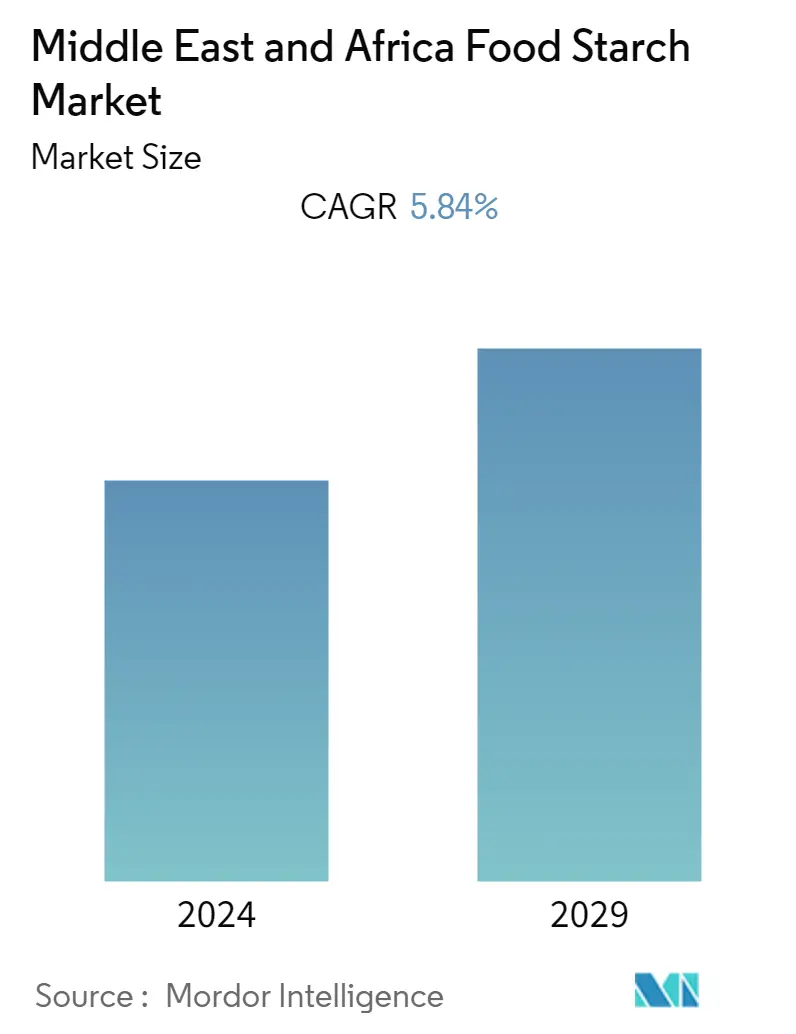Market Size of Middle East & Africa Food Starch Industry

| Study Period | 2019 - 2029 |
| Base Year For Estimation | 2023 |
| Forecast Data Period | 2024 - 2029 |
| Historical Data Period | 2019 - 2022 |
| CAGR | 5.84 % |
| Market Concentration | High |
Major Players
*Disclaimer: Major Players sorted in no particular order |
MEA Food Starch Market Analysis
The Middle East & Africa food starch market is projected to register a CAGR of 5.84% during the forecast period, 2022-2027.
The food additives business has been one of the industries most affected by COVID-19, which has been characterized by an unprecedented disruption in the operation of both market forces of demand and supply, providing challenges for all market parties. Measures implemented by the government are anticipated to worsen losses in the baking industry due to the potential of supply-side interruptions since over half of all enterprises reported large-scale disruptions in their supply chains due to COVID-19. The members of the six Gulf Cooperation Council (GCC) have responded aggressively to the increasing incidence of coronavirus cases with the closures of restaurants, bars, and lounges across the region. Many farm operations that require significant amounts of labor (mainly, the production of crops for the manufacturing of natural additives majorly food starches and food flavors) were severely affected. In addition, some farmers faced other distinct challenges, such as a steep drop in crop prices like corn. Due to limited demand from major industries including food and beverages, the utilization of corn starch fell considerably. According to FAOSTAT, the yield of corn in Kuwait decreased to 130,381 hg/ha in 2020 from 207,665 hg/ha in 2019.
Over the medium term, the demand for modified starches has been increasing in parallel to the rapid development of the food industry. The candy and confectionary industry has the leading demand for modified starch. Modified starch is widely preferred by the confectionery processors in the nation as it is one of the most effective and economical ways to improve the quality of confectionery products, acting as the binder for the candy ingredients, making the candy surface shiny, eye-catching and attractive to customers.
Additionally, the rise in demand for starch produced from wheat, which is used as a stabilizing and gelling agent in several end-use sectors, is one of the major factors driving the growth of the segment. Moreover, wheat starch is used as a thickening agent by food companies in various products. Nigeria's growing appetite for Western foodstuffs, specifically pasta, noodles snacks, and baked goods derived from wheat flour, is increasing, as the country is swaying away from its traditionally rice-heavy diet.
MEA Food Starch Industry Segmentation
Starch is a carbohydrate extracted from agricultural raw materials, which finds applications in literally thousands of everyday food and non-food products. Starches are derived from various sources, including corn, potato, wheat, and others. The Middle East & Africa food starch market (henceforth referred to as the market studied) is segmented based on type into native starch and modified starch. By source, the market studied is segmented into corn, wheat, potato, cassava, and other sources. By application, the market studied is segmented into confectionery, bakery, dairy, beverages, and other applications. Also, the report provides insights into the Asia-Pacific food starch market in the major economies across countries, including South Africa, the United Arab Emirates, Saudi Arabia, and the Rest of the Middle East & Africa. For each segment, the market sizing and forecasts have been done based on value (in USD million).
| By Type | |
| Native Starch | |
| Modified Starch |
| By Source | |
| Corn | |
| Wheat | |
| Potato | |
| Cassava | |
| Other Sources |
| By Application | |
| Confectionery | |
| Bakery | |
| Dairy | |
| Beverages | |
| Other Food and Beverage Applications |
| By Country | |
| South Africa | |
| United Arab Emirates | |
| Saudi Arabia | |
| Rest of the Middle East & Africa |
Middle East & Africa Food Starch Market Size Summary
The Middle East & Africa food starch market is experiencing a dynamic phase of growth, driven by the increasing demand for modified starches, particularly in the candy and confectionery sectors. The market is characterized by a diverse range of applications, including the use of starch as a stabilizing and gelling agent in various food products. The region's food processing industry, encompassing sectors such as bakery, dairy, and meat products, is a significant consumer of starches. The shift in dietary preferences, especially in countries like Nigeria, towards Western foodstuffs has further fueled the demand for wheat starch, which is used extensively as a thickening agent. The market is also witnessing a rise in consumer interest in convenience foods, particularly in South Africa, where the production of corn starch is prominent. Despite challenges posed by the COVID-19 pandemic, which disrupted supply chains and affected crop yields, the market is poised for recovery and growth.
The competitive landscape of the Middle East & Africa food starch market is highly fragmented, with key players such as Archer Daniels Midland Company, TATE & LYLE PLC, Cargill Incorporated, Ingredion Inc., and Roquette Frères leading the charge. These companies are focusing on innovation, research and development, and strategic partnerships to enhance their market position. The establishment of innovation centers and expansion of production facilities, such as Kerry Group's new plant in Africa, are indicative of the industry's commitment to meeting the growing demand for food starches. Additionally, the market is witnessing strategic acquisitions and partnerships, like Archer Daniels Midland Company's acquisition of Comhan, to strengthen their distribution networks and product offerings. As the market continues to evolve, these companies are well-positioned to capitalize on emerging opportunities and address the diverse needs of the region's food industry.
Middle East & Africa Food Starch Market Size - Table of Contents
-
1. MARKET DYNAMICS
-
1.1 Market Drivers
-
1.2 Market Restraints
-
1.3 Porter's Five Force Analysis
-
1.3.1 Threat of New Entrants
-
1.3.2 Bargaining Power of Buyers/Consumers
-
1.3.3 Bargaining Power of Suppliers
-
1.3.4 Threat of Substitute Products
-
1.3.5 Intensity of Competitive Rivalry
-
-
-
2. MARKET SEGMENTATION
-
2.1 By Type
-
2.1.1 Native Starch
-
2.1.2 Modified Starch
-
-
2.2 By Source
-
2.2.1 Corn
-
2.2.2 Wheat
-
2.2.3 Potato
-
2.2.4 Cassava
-
2.2.5 Other Sources
-
-
2.3 By Application
-
2.3.1 Confectionery
-
2.3.2 Bakery
-
2.3.3 Dairy
-
2.3.4 Beverages
-
2.3.5 Other Food and Beverage Applications
-
-
2.4 By Country
-
2.4.1 South Africa
-
2.4.2 United Arab Emirates
-
2.4.3 Saudi Arabia
-
2.4.4 Rest of the Middle East & Africa
-
-
Middle East & Africa Food Starch Market Size FAQs
What is the current Middle East & Africa Food Starch Market size?
The Middle East & Africa Food Starch Market is projected to register a CAGR of 5.84% during the forecast period (2024-2029)
Who are the key players in Middle East & Africa Food Starch Market?
Cargill Incorporated, Archer Daniels Midland Company, TATE & LYLE PLC, Ingredion Inc. and Roquette Frères are the major companies operating in the Middle East & Africa Food Starch Market.

